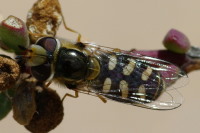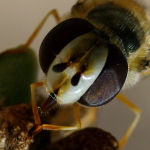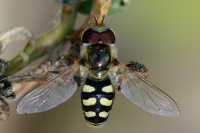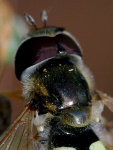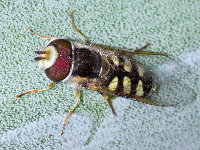Phylum Arthropoda (Arthropods) ➔ Subphylum Hexapoda (Hexapods) ➔ Class Insecta (Insects) ➔ Order Diptera (True flies) ➔ Family Syrphidae (Hoverflies)
Scaeva albomaculata (Macquart, 1842)
Synonyms and other combinations:
Lasiophticus gemellarii Rondani, 1845 | Lasiopticus sulphureus Sack, 1935 | Olbiosyrphus scufinus Dzhafarova, 1974 |
Classification:
Scaeva albomaculata belongs to the subfamily Syrphinae, tribe Syrphini.Distribution:
Iberian peninsula and round the Mediterranean basin to Morocco; Canary Islands; eastward through southern Russia, the Caucasus and southern Siberia to the far east and northern China; Afghanistan, Mongolia.Habitat:
Open ground, dry grassland.Description:
Thorax shiny; lateral margin of the mesoscutum with a distinct yellow, longitudinal stripe; abdomen with 3 pairs of whitish spots, spots on the tergites 3 and 4 oblique with almost straight anterior margin; sternites with narrow, black, transversely extending bands that almost reach the margins; front femora completely white-haired; forehead swollen; eyes hairy.A similar species is the Pied Hoverfly Scaeva pyrastri. In this, the front edges of the oblique patches on the tergites 3 and 4 are curved inwards.
Biology:
Scaeva albomaculata flies from mid of June to the beginning of September (throughout the year in the Canary Isles). The species is highly migratory. The adult flies visit flowers (e.g. Cytisus, Senecio and Thapsia ) for feeding on nectar and pollen .The larvae of Scaeva albomaculata feed on various species of aphids on herbs, shrubs and trees.
The development time of the species is strongly influenced by the environmental conditions. When rearing under laboratory conditions at 27°C, the larvae of Scaeva albomaculata hatched after 4 to 5 days. The 3 larval stages were completed in about 10 days. During this period, a larva consumed on average more than 500 aphids of the offered species Macrosiphum rosae (rose aphid). The larvae pupated and adults emerged after 6 to 7 days. Overall, preimaginal development takes about 3 weeks. When fed with honey solution and pollen, the imagines of Scaeva albomaculata lived 25 to 35 days, without food only about 4 days.
Predators:
Diplazon laetatorius (Hymenoptera: Ichneumonidae)Dotriothorax sp. (Hymenoptera: Encyrtidae)
References, further reading, links:
- Pape T. & Thompson F.C. (eds) (2017). Systema Dipterorum (version 2.0, Jan 2011). In: Species 2000 & ITIS Catalogue of Life, 2017 Annual Checklist (Roskov Y., Abucay L., Orrell T., Nicolson D., Bailly N., Kirk P.M., Bourgoin T., DeWalt R.E., Decock W., De Wever A., Nieukerken E. van, Zarucchi J., Penev L., eds.). Digital resource at www.catalogueoflife.org/annual-checklist/2017. Species 2000: Naturalis, Leiden, the Netherlands. ISSN 2405-884X.
- M.C.D.Speight: Species Accounts of European Syrphidae (Diptera), Glasgow 2011, Syrph the Net, the database of European Syrphidae, vol. 65, 285 pp., Syrph the Net publications, Dublin.
- Menno Reemer, Willem Renema, Wouter van Steenis, Theo Zeegers, Aat Barendregt, John T. Smit, Mark P. van Veen, Jeroen van Steenis, Laurens van der Leij: De Nederlandse Zweefvliegen (Diptera: Syrphidae), Nederlandse Fauna 8, 2009.
- Speight, M.C.D. & Sarthou, J.-P. (2014) StN keys for the identification of the European species of various genera of Syrphidae (Diptera) 2014 / Clés StN pour la détermination des espèces Européennes de plusieurs genres des Syrphidae (Diptères) 2014. Syrph the Net, the database of European Syrphidae, Vol. 80, 125 pp, Syrph the Net publications, Dublin
- Láska P., Pérez-Bañón C., Mazánek L., Rojo S., Ståhls G., Marcoz-García M. A., Bičík V. & Dušek J.: Taxonomy of the genera Scaeva, Simosyrphus and Ischiodon (Diptera: Syrphidae): Descriptions of immature stages and status of taxa, Eur. J. Entomol. 103: 637–655, 2006, ISSN 1210-5759
- Farzad Jalilian: Development and Feeding Capacity of Scaeva albomaculata (Macqaurt) (Diptera: Syrphidae) fed with rose aphid, Macrosiphum rosae (Homoptera: Aphididae), Biological Forum – An International Journal 7(1): 1377-1381(2015), ISSN No. (Print): 0975-1130, ISSN No. (Online): 2249-3239
- Anasimyia interpuncta
- Anasimyia transfuga
- Baccha elongata
- Brachyopa sp.
- Brachypalpoides lentus
- Brachypalpus laphriformis
- Brachypalpus sp.
- Brachypalpus valgus
- Ceriana conopsoides
- Ceriana vespiformis
- Chalcosyrphus femoratus
- Chalcosyrphus valgus
- Cheilosia albipila
- Cheilosia albitarsis
- Cheilosia chrysocoma
- Cheilosia illustrata
- Cheilosia pagana
- Cheilosia scutellata
- Cheilosia sp.
- Chrysogaster sp.
- Chrysotoxum bicinctum
- Chrysotoxum fasciatum
- Chrysotoxum festivum
- Chrysotoxum verralli
- Criorhina berberina
- Dasysyrphus albostriatus
- Dasysyrphus sp.
- Dasysyrphus tricinctus
- Didea fasciata
- Didea intermedia
- Didea sp.
- Epistrophe diaphana
- Epistrophe eligans
- Epistrophe flava
- Epistrophe melanostoma
- Epistrophe melanostoma/nitidicollis
- Epistrophella euchroma
- Eristalinus megacephalus
- Eristalis interrupta
- Eristalis intricaria
- Eristalis lineata
- Eristalis rupium
- Eristalis similis
- Eristalis sp.
- Eumerus purpurariae
- Eumerus sp.
- Eupeodes luniger
- Eupeodes sp.
- Ferdinandea cuprea
- Helophilus hybridus
- Helophilus sp.
- Helophilus trivittatus
- Ischiodon aegyptius
- Leucozona glaucia
- Leucozona laternaria
- Leucozona lucorum
- Melangyna lasiophthalma
- Melangyna quadrimaculata
- Melangyna umbellatarum
- Melanogaster sp.
- Meligramma triangulifera
- Meliscaeva cinctella
- Merodon ambiguus
- Merodon avidus
- Merodon moenium
- Merodon obscuritarsis
- Merodon sp.
- Microdon analis/major
- Microdon mutabilis/myrmicae
- Myolepta dubia
- Orthonevra sp.
- Paragus sp.
- Parasyrphus lineolus
- Parhelophilus sp.
- Pipiza austriaca
- Pipiza bimaculata
- Pipiza fenestrata
- Pipiza sp.
- Platycheirus rosarum
- Platycheirus sp.
- Rhingia rostrata
- Scaeva albomaculata
- Scaeva selenitica
- Sericomyia lappona
- Sphaerophoria rueppelli
- Sphaerophoria sp.
- Sphegina sp.
- Spilomyia saltuum
- Syrphus sp.
- Syrphus vitripennis
- Temnostoma bombylans
- Temnostoma meridionale
- Temnostoma vespiforme
- Tropidia scita
- Xanthogramma citrofasciatum
- Xanthogramma pedissequum
- Xylota sp.
- Xylota sylvarum
- Aspen Hoverfly
- Band-eyed Drone Fly
- Black-horned Smoothtail
- Brown-toed Forest Fly
- Bumblebee Hoverfly
- Chequered Hoverfly
- Common Bog Hoverfly
- Common Drone Fly
- Common Snout-hoverfly
- Deadhead Hover Fly
- Dusky-banded Forest Fly
- European Drone Fly
- Figwort Cheilosia
- Four-spotted Pipiza
- Hornet Mimic Hoverfly
- Large Hoverfly
- Large Narcissus Fly
- Larger Spotty-eyed Drone Fly
- Long Hoverfly
- Marmalade Fly
- Migrant Hoverfly
- Orange-belted Plumehorn
- Pied Hoverfly
- Pine Hoverfly
- Snouted Duckfly
- Summer Fly
- Sun Fly
- Tapered Drone Fly
- Thick legged Hoverfly
- White-banded Drone Fly
